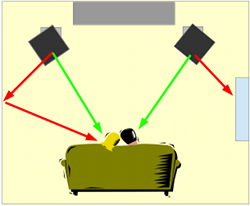With the right room acoustics, you’ll get clear and powerful sound in your home theater. Here are some guidelines.
1. Control Reverb
Reducing Reverb with Room Decor
Furniture – Fabric covered cushions, chairs and couches are perfect for absorbing sound energy. Hardwood furniture, glass tables and cabinets will only cause an increased reflection of sound and should be removed or covered with blankets or tapestry.
Floor Treatments– Hardwood floors and laminate should be covered as much as possible to prevent sound waves from being reflected. Try to use a carpet with natural fibers and thick padding or consider a large area rug if wall-to-wall is not an option.
Windows and Doors – Windows and doors are large sources of sound reflection and loss. Simply covering these areas with thickly draped curtains or blinds will help reduce sound reflection.
Reducing Reverb with Acoustic Panels
Many home theaters will benefit from acoustic panels to bring the amount of reverb in the room down to an ideal level.
Once you’ve chosen the flooring and other surface materials for your room, it’s time to determine how many acoustic panels, if any, you need. It’s not necessary to cover every surface in a room with acoustic panels to achieve ideal room acoustics. Our Free Online Room Acoustics Analysis is a great tool for determining the right amount of acoustical treatment for your room. Just provide some information about your room dimensions and surfaces, and our system crunches the numbers for you and provides an instant report and recommendation.
2. Determine Panel Placement
The most important thing is to have sufficient square footage of acoustic panels to bring the rooms overall reverb into an ideal range. Specific placement is less important, but can still make a difference. Often attractive appearance will guide placement just as much or more than specific acoustical considerations will.
There is some benefit in placing panels at first reflection points. These are places where the sound can come from the source, bounce once, and reach the listener. For example, on the side walls of a listening room approximately midway between the listener and the speakers.
Here’s a common method for finding first reflection points:
- Have a friend hold a mirror along the wall near a certain speaker at speaker height.
- The listener sits in a spot of normal viewing.
- The friend then moves slowly toward the listening position (stay along the wall).
- Mark each spot on the wall where the listener can see any of the room speakers in the mirror.
- The marked spots are the reflective areas in the room that make good locations for acoustic panel.

3. Control Low Frequency Sound
Low frequency sound (bass) has longer wavelengths, and is thus more susceptible to “piling up” in some areas of the room and cancelling itself out in others. This can produce uneven bass from one seating location to another. This is especially true in small rooms, like the size of most home theaters. Bass traps are designed to reduce this type of problem. Use ATS Bass Traps in two or more corners to even out your bass.
4. (Optionally) Get Artistic
While absorbing sound, acoustic panels can also add artistic appeal to your home theater. ATS Acoustic Art Panels are custom made with any image or photo you can think of. You provide the image, we print it on fabric, and build your panel with the printed fabric. Family photos, old movie posters, your favorite movie stars, anything is possible.

A classic movie poster image used in an Acoustic Art Panel design.
We also offer custom size acoustic panels when you need to fit a certain space or work around a door opening, etc.
5. Enjoy!
Sit back, crank up the volume, and enjoy the action with clear, powerful sound.

